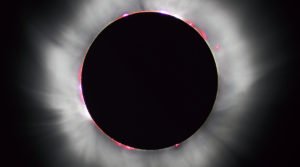
via Wikipedia
A show called The World aired a story on Public Radio International (PRI) last week about an app called eclipse soundscapes made especially for people who are blind or have visual impairments.
I could see fine when I was a kid, and I watched the total eclipse of the sun on March 7, 1970 using a pinhole camera our school teachers taught us to make out of cardboard shoeboxes. I didn’t look at the sun directly, and I didn’t lose my sight back then! My blindness came 15 years later, due to a totally unrelated eye disease called retinopathy.
When I heard the PRI story was titled “Helping the Blind See the Solar Eclipse” I almost turned the radio show off. Hearing things touted as allowing “the blind to see” like that usually leaves me feeling sad. As cool as this new eclipse app might be for people who are blind, I knew it wouldn’t allow us to watch the eclipse.
But something about this thing being created for “NASA’s Heliophysics Education Consortium” and the Smithsonian Astrophysicalogical Observatory with an astrophysicist from Harvard and co-sponsored by the National Park Service, well, gee whiz, it caught my attention!
The PRI story included a link to a web site for more information about the eclipse, and the wording about the soundscapes app< there is just right. It says that for people "who are unable to see the eclipse with their own eyes, the Eclipse Soundscapes Project delivers a multisensory experience of this exciting celestial event.” Not a word about us seeing the eclipse. They acknowledge we can’t see.
I was so taken by the way this site describes what it will do for those of us who are blind that I’m going to give it a try tomorrow. The site explains that the app includes a narration of the eclipse’s progression in real time and a rumble map that will let us use our sense of touch to “geolocate the user and start the narration to align with the planetary movements as they occur.” What does that mean? I sure don’t know. But maybe I’ll be able to tell you tomorrow.
This sounds really cool! I’m leaving in about 10 minutes (3 a.m.) to head to southern Illinois for the eclipse.
No surprise there, you are a scientists through and through. I love all the attention southern Illinois is getting, and eager to hear your reports when you return. Safe travels, Pat —
I am going to try this!
You know, it hadn’t occurred to me. This could be the answer for all the people who haven’t been able to get their hands on a pair of those special eclipse safety sunglasses!
So funny you mentioned a pinhole camera made from a shoebox. We also did that in grade school and it is the only solar eclipse I remember. Hope you have fun with this app, it sounds like a great way to experience this rare celestial event. Please do a follow up and let us know how it worked.
Will do. Hope it works….
Wow, I love this multi-sensory approach! I always think of you, Beth, when I see these apps and other services that promise to “help the blind see” through some technological innovation or another. It seems like an over promise as best and offensive and condescending at worst. I also read about how it will be interesting to pay attention to animals to see how they deal with the strangely timed darkness of the eclipse… that birds may start to sing their evening songs and crickets might start to chirp. I hope this app lets you “experience” the eclipse in an enjoyable and interesting way! xo
Well put, Carli: somewhere between overpromising and offensive and condescending. I like the stuff about the animals and birds, too –I can already thank the app for even making me think about that aspect.
Leave a Response